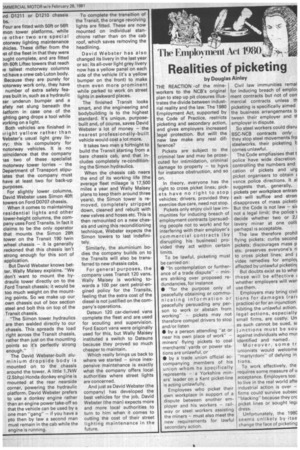The Em p loyment Act 1980 .4
Page 41

If you've noticed an error in this article please click here to report it so we can fix it.
Realities of picketing
by Douglas Ainley
THE REACTION -of the mineworkers to the NCB's original plan to step up pit closures illustrates the divide between industrial reality and the law. The 1980 Employment Act, supported by the Code of Practice, restricts picketing and secondary action, and gives employers increased legal protection. But willl the new law make any real difference?
Pickets are subject to the criminal law and may be prosecuted for intimidation, criminal damage to property — to hgvs for instance obstruction, and so on.
In theory, everyone has the right to cross picket lines; picket s have no right to stop vehicles; drivers, provided they exercise due care, need not stop.
Pickets only enjoy civil law immunities for inducing breach of employment contracts (persuading people not to work) and for interfering with their employer's commercial contracts (by disrupting his business) provided they act within certain limits.
To be lawful, picketing must be carried on:
• "In contemplation or furtherance of a trade dispute" — miners striking over proposed redundancies, for instance
• "for the purpose only of peacefully obtaining or communicating information or peacefully persuading any person to work or abstain from working" pickets may not therefore compel drivers to stop and/or listen
• by a person attending "at or near his own place of work" — miners' flying pickets to coal merchants' yards or power stations are unlawful, or
• by a trade union official accompanying members of his union whom he specifically represents — a Yorkshire miners' leader on a Kent picket-line is acting unlawfully.
Employees who picket their own workplace in support of a dispute between another employer and his workers — railway or steel workers assisting the miners — must also meet the new requirements for lawful secondary action.
Civil law immunities remai for inducing breach of emplo) ment contracts but not of con mercial contracts unless th picketing is specifically aimed the business arrangements b tween their employer and tlemployer in dispute.
So steel workers could disru BSC-NCB contracts only: they stop steel movements fro steelworks, their picketing b comes unlawful.
The Code emphasises that t police have wide discretion controlling the numbers and cation of pickets and urg picket organisers to obtain E vance police directions. It al suggests that, generally, pickets per workplace entrani exit will suffice and stron disapproves of mass picketii But the Code is not law — not a legal limit; the police decide whether two or 2,( (every miner at one colli perhaps) is acceptable.
The law therefore .prohil flying pickets; curbs second pickets; discourages mass p ets; preserves everyone's ri to cross picket lines; and vides remedies for emploN affected by unlawful picketinc But doubts exist as to whet these will be effective whether employers will wan use them.
Employers may bring civil tions for damages (rar( practice) or for an injunction hibiting the unlawful action. legal actions, especially small firms, are costly. Un as such cannot be sued, Sc j‘inctions must be sou against individuals who mu: identified and named.
Moreover, some tr unionists would welcome "martyrdom" of defying in tions.
To work effectively, the requires some measure of u acceptance. Employers too to live in the real world afte industrial action is over — firms could survive subsec "blacking" because they crc picket lines or sought legE dress.
Unfortunately, the 1980 seems unlikely by itse change the face of picketing




























































































